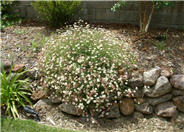
Common name:Crape Myrtle
Botanical name:Lagerstroemia indica
The new leaves of this species are 2" long, bright green, and tinged with bronze. Some cultivars have spectacular fall color. When it has a bare outline, its rounded seed capsules add interest. Its delicate flowers bloom in 6"-12" long clusters. The flower colors could be shades of red, rose, pink, purple, and white, blooming in summer. It thrives on heat, and new cultivars have been created that resist mildew. This tree prefers full sun and has low watering needs once it's established.

Common name:Mexican Bush Sage, Mexican Sage
Botanical name:Salvia leucantha
The Mexican Sage is a bushy shrub that grows 3'-4' tall and wide. It has hairy white stems, grey-green leaves and velvet-like purple flower spikes that bloom summer through fall. This shrub tolerates sun, light shade, little water, and is hardy to 15 degrees F. The Mexican Sage attracts hummingbirds. Be careful not to overwater. -Cornflower Farms

Common name:Homestead Purple Verbena
Botanical name:Verbena 'Homestead Purple'
This perennial will reach about 3' tall and has small green leaves with purple flowers that bloom during warm weather. It is frost tender but will come back when the ground warms up. Feed with an all-purpose fertilizer once a month during the growing season. This shrub works as a great groundcover. Pinch ends to promote dense growth.

Common name:Powis Castle Artemisia
Botanical name:Artemisia 'Powis Castle'
This mounding shrub reaches 3 ft. high and up to 5ft. wide with fine silver foliage. It does well in coastal areas as well as inland warm areas. It rarely blooms but is used for its beautiful foliage. It is striking next to perennials with bright colors. This shrub prefers full sun and well draining soil. It is drought tolerant once it's established.

Common name:Coast Redwood, Redwood
Botanical name:Sequoia sempervirens
This fast-growing, aromatic tree has soft, dark green foliage with long needles appearing in flat sprays and brown, barrel-shaped cones that appear after 1 year. Its soft, red-brown bark is fiberous and furrowed. Particularly after mechanical damage, this tree will stump sprout to form new, young trees around the stump. Avoid planting in areas of high foot traffic.

Common name:Santa Barbara or Mexican Daisy
Botanical name:Erigeron karvinskianus
This low mounding perennial, with fine leaves and white to pinkish daisy-like flowers, is an excellent asset to rock gardens.

Common name:Maidenhair Tree, Ginkgo Tree
Botanical name:Ginkgo biloba
The Ginkgo biloba, with its distinct fan-shaped leaves, initially grows with a pyramidal habit, but later becomes wide-spreading. It is generally not bothered by insects or disease. It slowly reaches 35'-50' tall and wide. It needs regular watering and more during hot summer months. Flowers are inconspicuous. Fall color is spectacular with changing color of leaves from light green with a yellow tinge to yellow.

Common name:Elijah Blue Fescue
Botanical name:Festuca glauca 'Elijah Blue'
The 'Elijah Blue' is a lovely ground cover grass with silver blue foliage that quickly reaches 12" tall and wide. This evergreen grass has golden flowers that bloom in summer. However, 'Elijah Blue' is grown for its foliage. Plant in full sun in coastal areas; in warm inland areas, it should receive afternoon shade to prevent it from turning brown. It is drought tolerant once it's established. It prefers well draining soil.
More than half of the water used at your home is for outside purposes. Studies show that on average, half of the water used outdoors is wasted. The leading cause of waste is incorrectly set and poorly managed irrigation controllers. The second biggest cause of wastage is broken irrigation equipment that goes undetected. There are a few basic things you can do to make a big difference in your water use.
Click in the green box for more information
Designer:
Photographer: GardenSoft
Practice grass-cycling by leaving short grass clippings on lawns after mowing, so that nutrients and organic matter are returned to the soil.
Drip and other smart irrigation delivers water directly to roots, allowing no excess water for weeds.